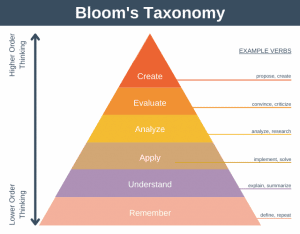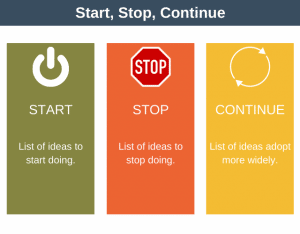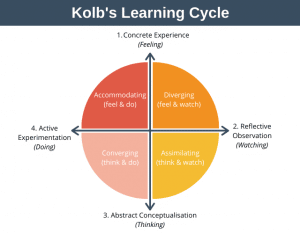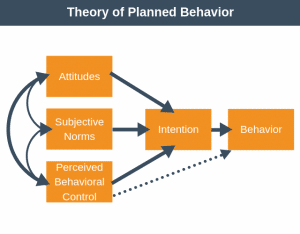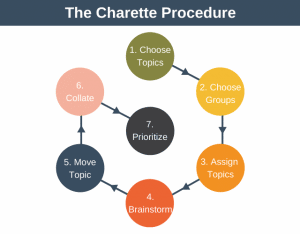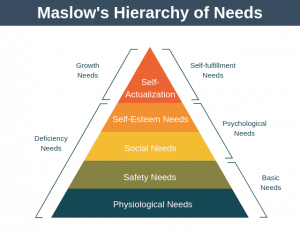The train-the-trainer model is used to train trainers or subject matter experts so that they can then teach others effectively.
Imagine you’re an expert at using a particular software package. Right now, you’re the only person within your organization with any experience of using this package.
This software is about to be rolled out across your entire organization. Your boss asks you to train the rest of the organization to use this software through a series of workshops.
Over the course of a few days, you create some training materials and use them in your workshops to train the rest of the organization to use the new software.
Can you see any problems with this approach?
There are many, but the most serious problems are:
- You are an expert with the software, but you are no expert in teaching others.
- While you have lots of experience using the software, you may not be as good at using it as you think you are.
The train-the-trainer model overcomes these issues as it is based on the principle that in order to provide effective training, you need to become an expert at two things: your subject and teaching.
Thus, courses built using the train-the-trainer model improve your skills in both the subject you want to teach and how best to transfer that knowledge to your future students.
Another Problem
Another issue with the scenario above is that our solution doesn’t scale. If there are 20,000 people in your organization then it’s simply not possible for you alone to train everyone via small workshops.
Because the train-the-trainer model trains trainers who then deliver the training, the model enables you to deliver consistent training at scale.
Characteristics of a Good Trainer
Before we examine the train-the-trainer model, let’s take a moment to look at the characteristics of people who make good trainers.
These personality traits are important because not everyone is suited to training others.
The greater the number of these characteristics a potential trainer has, the more likely they are to be a good trainer:
- Gravitas: the potential trainer must be well respected within the organization. This increases the likelihood that students will actively want to learn from them.
- Communication skills: to train others, good communication skills are required. It’s essential to be able to stand up in front of a room of students and be able to present confidently, concisely, accurately, and clearly.
- Expertise: if not already an expert, then it is usual for the potential trainer to at least have some knowledge of the subject they will be teaching. With no subject matter expertise, then depending on the subject, the learning curve could be challenging, if not impossible, to overcome. For example, it’s impossible to learn to speak and french in a few weeks.
- Empathy and flexibility: the potential trainer needs empathy and flexibility to be able to pick up on the training needs of their students and adapt their training to best suit their student’s needs.
- Open to feedback: potential trainers need to be receptive to feedback. This is especially true when the potential trainer is a subject matter expert and may have strong views about not only what should be taught but also the manner in which it should be taught.
Creating a Train-the-Trainer Program
If you want to create a train-the-trainer session or course within your organization, then here are some important best practices to consider:
1. Define your goals
Begin by deciding what it is you want your train-the-trainer course to achieve. Some common objectives include:
- Train technical experts to be able to impart their knowledge to others.
- Train employees to be able to onboard new employees.
- Build a core team of trainers who will train the entire organization whenever any new IT system (or another new way of working) is rolled out.
2. Define how to measure progress
Now that you understand the goals you are trying to achieve, you need to determine how you will track progress towards those goals.
Typically, the trainers’ competence will be measured at both the beginning and end of the course. They will usually be assessed on both their technical expertise as well as their teaching expertise.
3. Design your train-the-trainer course
Now it’s time to design the modules that you will teach as part of your train-the-trainer course.
If your teaching subject matter experts, then it’s likely you’ll spend a significant proportion of your time teaching them teaching skills. If your teaching experienced trainers, then you’ll spend a more significant proportion of the time teaching the subject itself.
4. Create training materials
Finally, it’s time to create your training materials. There are two sets of materials that you’ll need to make:
- Materials for your train-the-trainer course.
- Materials that your trainers will use to teach the subject to others. Providing these materials to your trainers helps ensure consistency as you rollout the training into the wider organization.
It is important that you create training materials that cater to the different ways in which people like to learn. For example, some people prefer to learn from doing whereas others may prefer to learn from reading a book. To learn more about different learning preferences, read our article on Kolb’s Learning Cycle.
Train-the-Trainer Example
Now that we’ve designed our train-the-trainer course let’s take a look at an example of how such a course might be run in practice.
There are three actors in this example you need to be aware of:
- Master trainer: the trainer that will run the train-the-trainer course.
- Potential trainers: the wannabe trainers who attend the train-the-trainer course.
- Students: the students that will be taught by the potential trainers once they have successfully completed the train-the-trainer course.
The diagram below shows the four key steps the potential trainers move through during the train-the-trainer process.
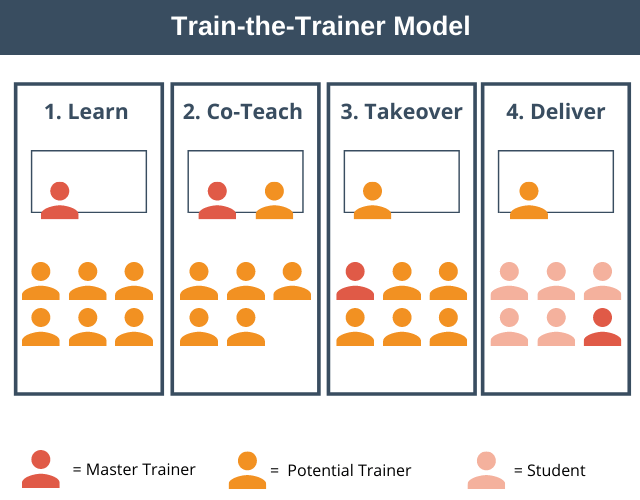
Step 1: Learn
In this step, Potential Trainers will attend the train-the-trainer course run by the Master Trainer. The Master Trainer will have already created the course that the Potential Trainers will eventually trach to Students. The course will consist of learning the material and learning the best ways to teach the material.
Step 2: Co-teach
Now that all of the course material as been taught by the Master Trainer, each Potential Trainer will have an opportunity to present one or more modules the course to their peers (other Potential Trainers).
This will be done alongside the Master Trainer so that they can get feedback on how to improve their performance interactively as they deliver the training.
Step 3: Takeover
Once the Potential Trainers have delivered their training in conjunction with the Master Trainer, it’s time to deliver one or more modules of the course alone, without interactive feedback.
In this step, feedback will only be provided by the Master Trainer once the Potential Trainer has finished delivering their training.
If the Potential Trainer performs at the required standard, it’s time to move to the next step where each Potential Trainer delivers the training to real students.
Step 4: Deliver
In this step, the Potential Trainer is no longer a Potential Trainer, but an actual Trainer, and they must deliver the training for real to actual students.
Note that it is common for the Master Trainer to attend the first course the new trainer delivers to provide final corrective feedback to the Trainer as they deliver their course to real students.
Advantages and Disadvantages
Advantages
The benefits of the train-the-trainer model include:
- It provides a mechanism to roll out training across an organization at scale in a cost-effective way. Note that the model is cost-effective because you only have to hire at most one master trainer if you don’t already have one. The rest of the people involved in the process are already permanent employees.
- Its cascade style results in a consistent way to roll out training across an organization.
- It helps you develop a very competent internal training team.
- Because trainers are permanent employees of the organization and not external trainers, it allows students to ask follow up questions after their training has finished. This would not be possible with external trainers.
- Internal trainers understand their own organization better than an external trainer could. This allows them to better tailor their training to the specific needs of their organization.
Disadvantages
The disadvantages of the train-the-trainer model include:
- If you need to train people very quickly, then it may be quicker to bring external trainers.
- Ongoing monitoring is required to ensure that training continues to meet the intended purpose of the training.
- Care must be taken to ensure that the training remains up to date.
Summary
The train-the-trainer model provides organizations with an efficient way to rollout training at scale.
The train-the-trainer model works by having an expert trainer train internal employees to become trainers in a specific subject. These internal employees, now trainers, can then train others within the organization using what they have learned.
During a train-the-trainer course, potential trainers will learn the subject they will be teaching and the teaching skills necessary to teach their subject in the best way.

